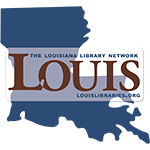Medical Terminology
Topic outline
-
This course is designed to teach medical terminology, the language of medicine, in an engaging and meaningful way. Learning medical terminology will allow the learner to more easily understand the language of medicine and utilize this knowledge throughout their academic and medical-based career. While learning medical terms in this course, the learner will also learn basic anatomy and physiology, as well as basic diseases and professions dealing with each body system. The course starts the learner off by explaining the way that word parts are put together and then introduces the words and their parts within each body system. The combination of word lists and their definitions with interactive content and real-world scenarios will aid the learner to understand, retain, and utilize the information within.
Upon successful completion of this course, the student will be able to:
-
Analyze, build, and define medical terms correctly using knowledge of word parts
-
Demonstrate proper pronunciation and spelling of medical terminology
-
Utilize medical terminology on body systems
-
Decipher medical terms and abbreviations related to health professions
-
Select correct medical terms basic medical terms to facilitate communication in the medical setting
Begin the course by reading the syllabus and introducing yourself in the forum "Getting Started" section of this course.
Adopting institution should provide learners information on how to navigate the course. Consider adding an introductory navigation video. Text description could include, for example:Navigating the Course
This course is set up in Modules covering various topics which may be accessed from the course navigation menu on the left or by scrolling below. Modules may be collapsed in the menu and it the body of the course to minimize scrolling. Each module includes the relevant chapters followed by various activities, which may include discussion forums, listening activities and quizzes, practice quizzes, module tests, and other relevant activities as appropriate for each module. Many items are required and may be marked as completed automatically when the activity has been submitted (the broken check box), but others will marked as done by the student (the solid check box).Please move through the items below and continue through the Learner Support and Getting Started modules before moving on to Module 1. Be sure to check for announcements and due dates to stay on track.This course and its contents are licensed under a Creative Commons Attribution 4.0 International License by LOUIS: The Louisiana Library Network, except where otherwise noted.
-
-
Introduction to Word Parts and Medical Language Rules
-
This module contains all the items you should review and complete before you begin Module 1. Before moving on, be sure to:
- Check the News and Announcements Forum
- Read the Course Syllabus
- Introduce yourself to the class
- Read the instructions for the Q & A Forum
Good luck in the course!-
-
Use this forum to tell us a little about yourself and your interests. Some topic ideas:
- What is your field of study/research interest or concentration?
- What are you most interested in learning about in this class and why?
- Have you ever taken an online class before?
- Any other information you would like to share with your classmates, such as special interests or activities.
Post a picture! We look forward to meeting you.
-
Use this forum to ask your instructor any questions you have about the course. You may post at any time, and your instructor will respond here. Be as specific as possible.
Please keep in mind that others can see your posts, so do not post any personal information. If you have questions about your grade, please email your instructor directly. You can expect a response to posts and emails within [X] hours. [Recommendation is 24 hours M-F, next business day on weekends.]
Subscription should be set to Auto.
- Check the News and Announcements Forum
-
Use the information in this module to customize the template to your needs. This module is currently hidden from students, and available for you to refer to throughout the semester.
-
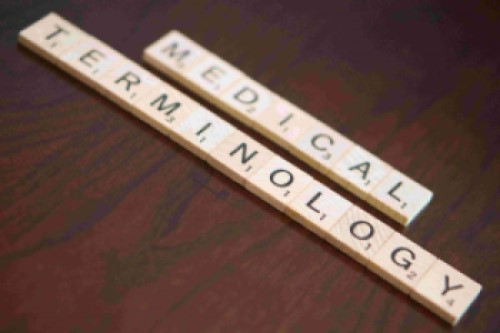 This module will cover the basics of medical terminology - word origins, prefixes, suffixes, and how to combine words parts to create the medical terms we'll use in subsequent chapters. The terms and concepts learned here will be useful in any future career in the medical field.
Upon completion of this module, you will be able to:
This module will cover the basics of medical terminology - word origins, prefixes, suffixes, and how to combine words parts to create the medical terms we'll use in subsequent chapters. The terms and concepts learned here will be useful in any future career in the medical field.
Upon completion of this module, you will be able to:- Identify the various word parts in medical terminology. (Course Objective 1)
- Divide words into prefixes, suffixes, combining forms and combining vowel. (Course Objective 1)
- Apply spelling and pronunciation rules to creating words from prefixes, word roots, combining vowels, and suffixes. (Course Objectives 1 & 2)
- List commonly-used prefixes and suffixes and their meanings. (Course Objective 1)
To achieve these objectives:
- Read the Module 1 Introduction
- Read the "Introduction" and Chapter 1, "Introduction to Word Parts and Medical Language Rules" from the Medical Terminology textbook.
- Complete the Practice Activities. (Note: To receive a grade for this, you must click the "Practice Activities" link below.)
- Add your initial posts and responses to the Module 1 Discussion.
- Complete the Module 1 Quiz.
Note the check boxes to the right that help you track your progress: some are automatic, and some are manual.
Module Pressbooks Resources and Activities
Click the links below to access the reading and complete the discussion, exercises, and quiz. -
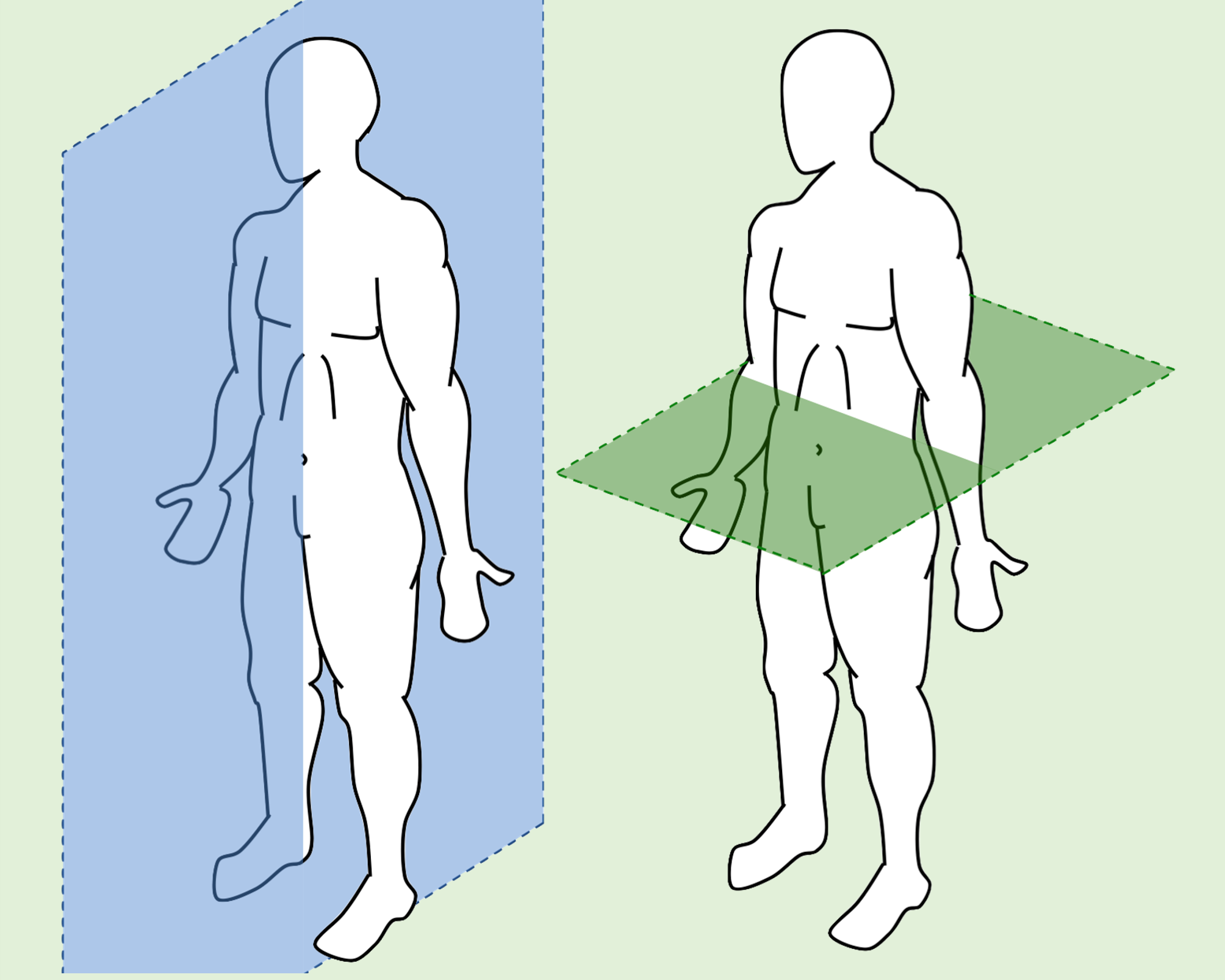 This module will introduce terms used for body direction, anatomical planes, regions, and quadrants. Anatomists and health care providers use this universal terminology for the purpose of precision and to reduce medical errors. By using precise anatomical terms, we eliminate ambiguity and create a unifying language used by scientists and medical professionals. Because these word parts are used to describe locations and body positions, you may also see terms from this unit in many of the other units. Learning these medical terms will assist you to build the foundation needed for the language used in any medical career.
Upon completion of this module, you will be able to:
This module will introduce terms used for body direction, anatomical planes, regions, and quadrants. Anatomists and health care providers use this universal terminology for the purpose of precision and to reduce medical errors. By using precise anatomical terms, we eliminate ambiguity and create a unifying language used by scientists and medical professionals. Because these word parts are used to describe locations and body positions, you may also see terms from this unit in many of the other units. Learning these medical terms will assist you to build the foundation needed for the language used in any medical career.
Upon completion of this module, you will be able to:- Identify the anatomic position and its use in medical terminology. (Course Objective 5)
- Define, pronounce and spell directional terms. (Course Objectives 1 & 2)
- Define, pronounce and spell anatomic planes. (Course Objectives 1 & 2)
- Define, pronounce and spell terms used to describe the abdominal regions. (Course Objectives 1 & 2)
- Interpret the meaning of abdominal quadrant abbreviations. (Course Objectives 4 & 5)
To achieve these objectives:
- Read the Module 2 Introduction
- Read Chapter 2, "Directional Terms and Anatomic Planes, Regions and Quadrants" from the Medical Terminology textbook.
- Complete the Practice Activities. (Note: To receive a grade for this, you must click the "Practice Activities" link below.)
- Add your initial posts and responses to the Module 2 Discussion.
- Complete the Module 2 Quiz.
Module Pressbooks Resources and Activities
Click the links below to access the reading and complete the discussion, exercises, and quiz. - Identify the anatomic position and its use in medical terminology. (Course Objective 5)
-
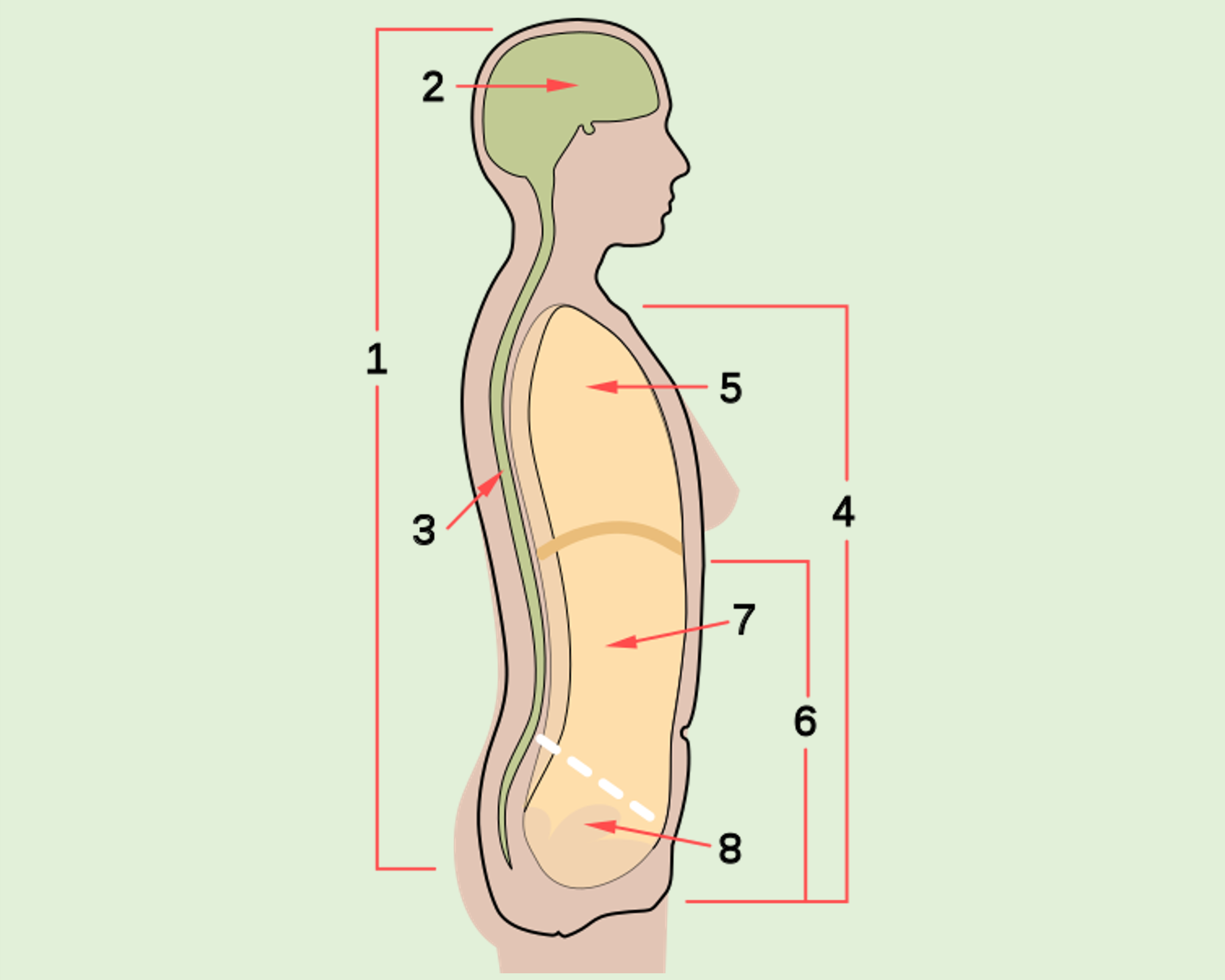 This module will cover the organization of the human body, as well as naming basic structures - organ systems, tissues, membranes, cavities, colors, and tumors/cancers . The terms and concepts learned here will be useful in any future career in the medical field.
This module will cover the organization of the human body, as well as naming basic structures - organ systems, tissues, membranes, cavities, colors, and tumors/cancers . The terms and concepts learned here will be useful in any future career in the medical field.(“Scheme body cavities numbered” by Jmarchn is used with a CC BY-SA 3.0 license.)
Upon completion of this module, you will be able to:
Connect medical language learning to the context of anatomy and physiology. (Course Objective 5)
Introduce the basic architecture and levels of organization of the human body. (Course Objective 5)
Describe body cavities and the functions of associated membranes. (Course Objective 5)
Define and spell word parts related to color. (Course Objectives 1 & 2)
Define and spell word parts related to oncology. (Course Objectives 1 & 2)
To achieve these objectives:
- Read the Module 3 Introduction.
- Read Chapter 3, "Body Structure, Color, and Oncology" from the Medical Terminology textbook.
- Complete the Practice Activities. (Note: To receive a grade for this, you must click the "Practice Activities" link below.)
- Add your initial posts and responses to the Module 3 Discussion.
- Complete the Module 3 Pronunciation Exercise.
Complete the Module 3 Quiz.
Module Pressbooks Resources and Activities
Click the links below to access the reading and complete the discussion, exercises, and quiz. -
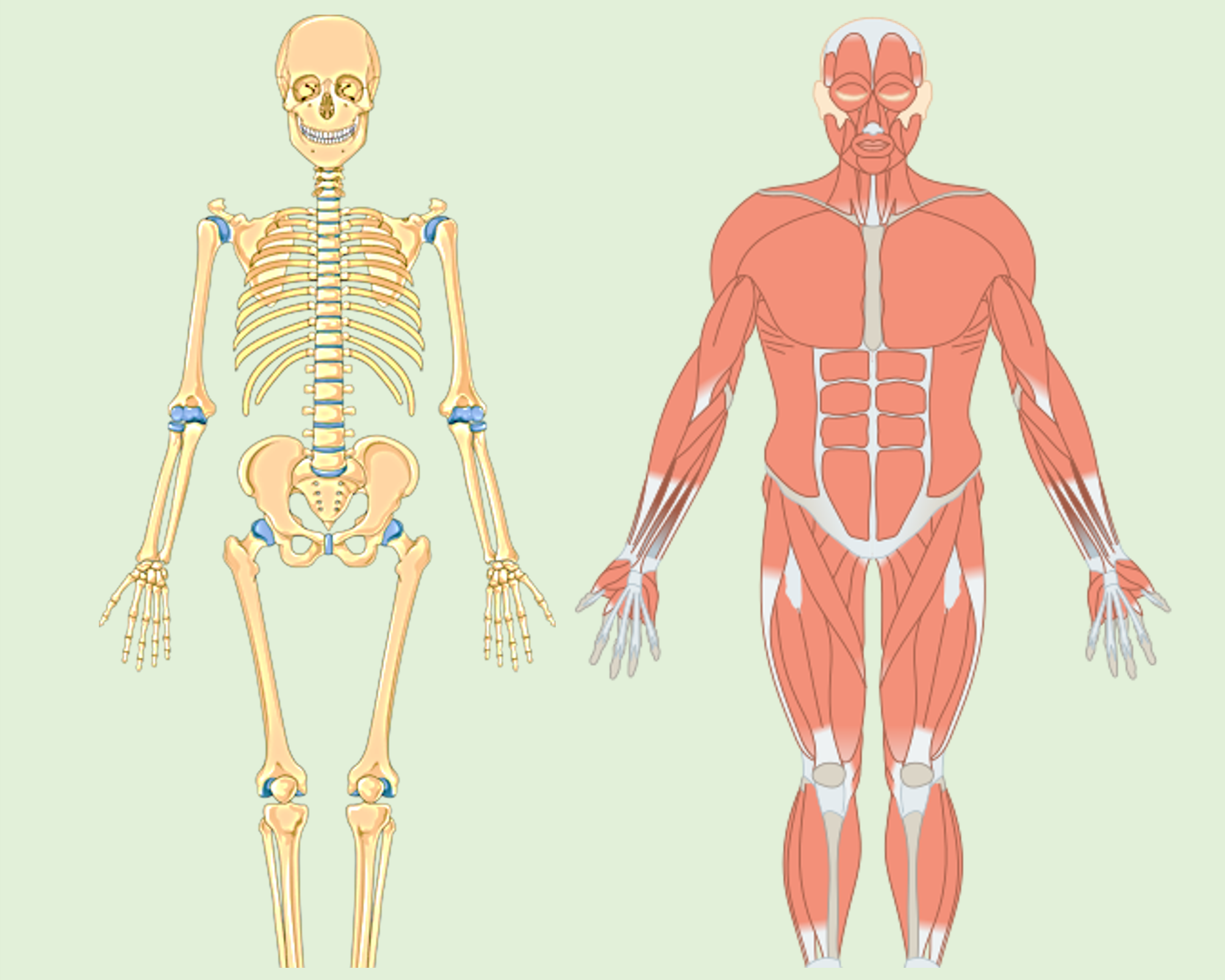
This module will cover the medical terminology of the muscular and skeletal systems and introduce the anatomy of these two systems to gain a better understanding of the words and their parts. The skeletal system consists of the bones of the skeleton, the joints where the bones meet, and the ligaments that hold the skeleton together. The muscular system consists of the voluntary muscle attached to the skeleton and the tendons that attach the muscles to the skeleton. Each system has its own functions, such as protection, heat production, and movement, but they are so intertwined, that they are often studied together. The terms learned here will be useful in many future career paths, such as orthopedics, chiropractic medicine, podiatry, sports medicine, and kinesiology.
(“Muscles front and back” by OpenStax & Tomáš Kebert & umimeto.org is used with a CC BY-SA 4.0 license. "Skeletal 3” by Laboratories Servier is used with a CC BY-SA 4.0 license.)Upon completion of this module, you will be able to:- Identify the anatomy of the musculoskeletal system. (Course Objective 3)
- Describe the main functions of the musculoskeletal system. (Course Objective 3)
- Spell the medical terms related to the musculoskeletal system and use the correct abbreviations. (Course Objectives 2 & 4)
- Pronounce the medical terms related to the musculoskeletal system. (Course Objective 2)
- Identify the medical specialties associated with the musculoskeletal system. (Course Objectives 3 & 5)
- Discuss and describe common diseases, disorders, and procedures related to the musculoskeletal system. (Course Objectives 3 & 5)
To achieve these objectives:
- Read the Module 4 Introduction.
- Read Chapter 4, "Musculoskeletal System" from the Medical Terminology textbook.
- Complete the Practice Activities. (Note: To receive a grade for this, you must click the "Practice Activities" link below.)
- Add your initial posts and responses to the Module 4 Discussion.
- Complete the Module 4 Pronunciation Exercise.
- Complete the Module 4 Quiz.
Module Pressbooks Resources and Activities
Click the links below to access the reading and complete the discussion, exercises, and quiz. - Identify the anatomy of the musculoskeletal system. (Course Objective 3)
-
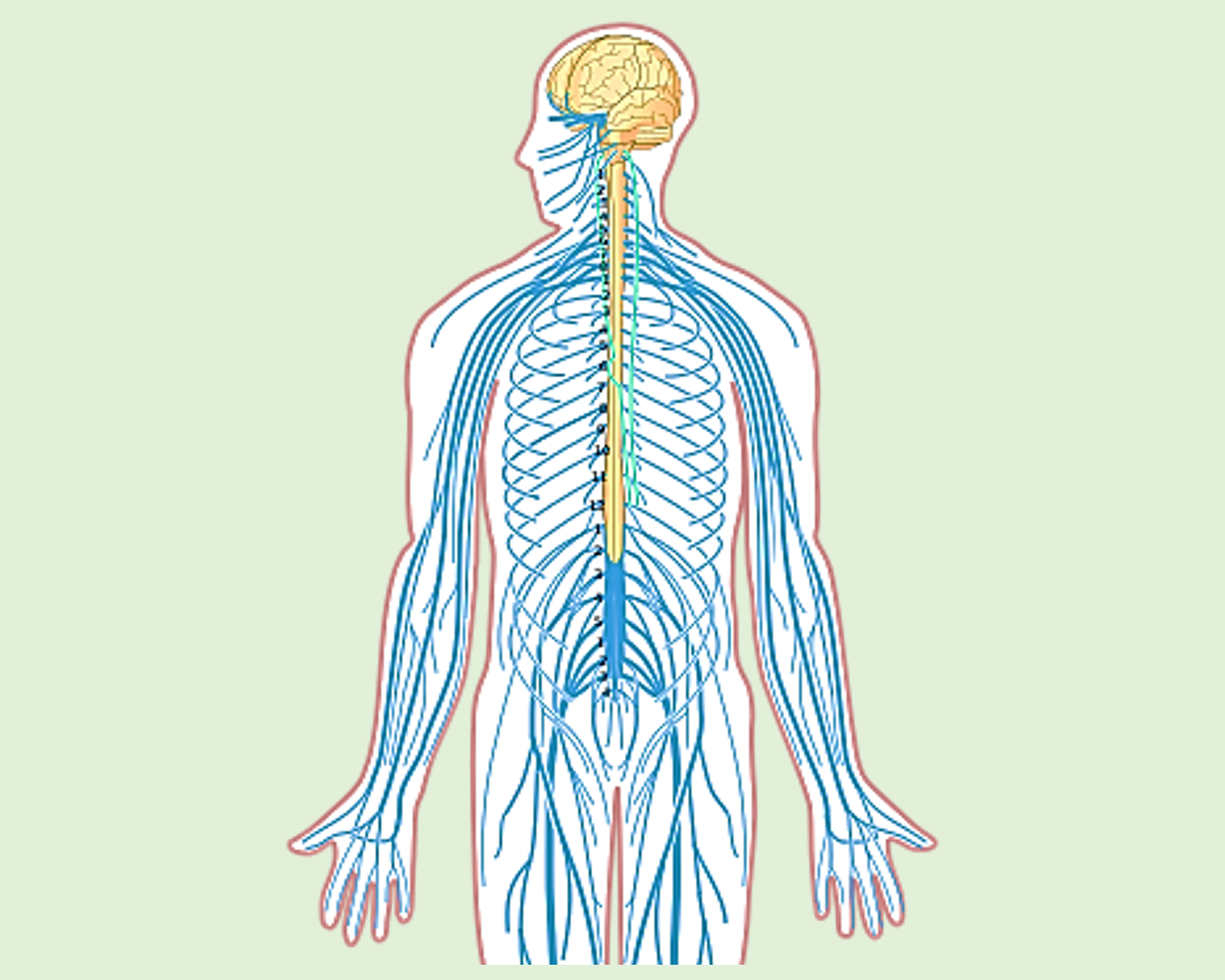
This module will cover the medical terminology of the nervous system and introduce the anatomy of this system to gain a better understanding of the words and their parts. The nervous system consists of the brain and spinal cord in the central nervous system, and the cranial and spinal nerves of the peripheral nervous system. The function of the nervous system is to control and regulate all other body systems, maintaining the delicate balance that keeps the body alive. The terms learned here will be useful in many future career paths, such as medicine, nursing, psychiatry, and pharmacology. The senses (Chapter 15) are an extension of the nervous system, and the endocrine system (Chapter 6) assists the nervous system to control and regulate body functions, so some of the terms studied in this chapter may also appear in those chapters as well.
Upon completion of this module, you will be able to:- Identify the anatomy of the nervous system. (Course Objective 3)
- Describe the main functions of the nervous system. (Course Objective 3)
- Spell the medical terms related to the nervous system and use correct abbreviations. (Course Objectives 2 & 4)
- Pronounce the medical terms related to the nervous system. (Course Objective 2)
- Identify the medical specialties associated with the nervous system. (Course Objectives 3 & 5)
- Discuss and describe common diseases, disorders, and procedures related to the nervous system. (Course Objectives 3 & 5)
To achieve these objectives:
- Read the Module 5 Introduction
- Read Chapter 5, "Nervous System" from the Medical Terminology textbook.
- Complete the Practice Activities. (Note: To receive a grade for this, you must click the "Practice Activities" link below.)
- Add your initial posts and responses to the Module 5 Discussion.
- Complete the Module 5 Pronunciation Exercise.
- Complete the Module 5 Quiz.
Module Pressbooks Resources and Activities
Click the links below to access the reading and complete the discussion, exercises, and quiz. -
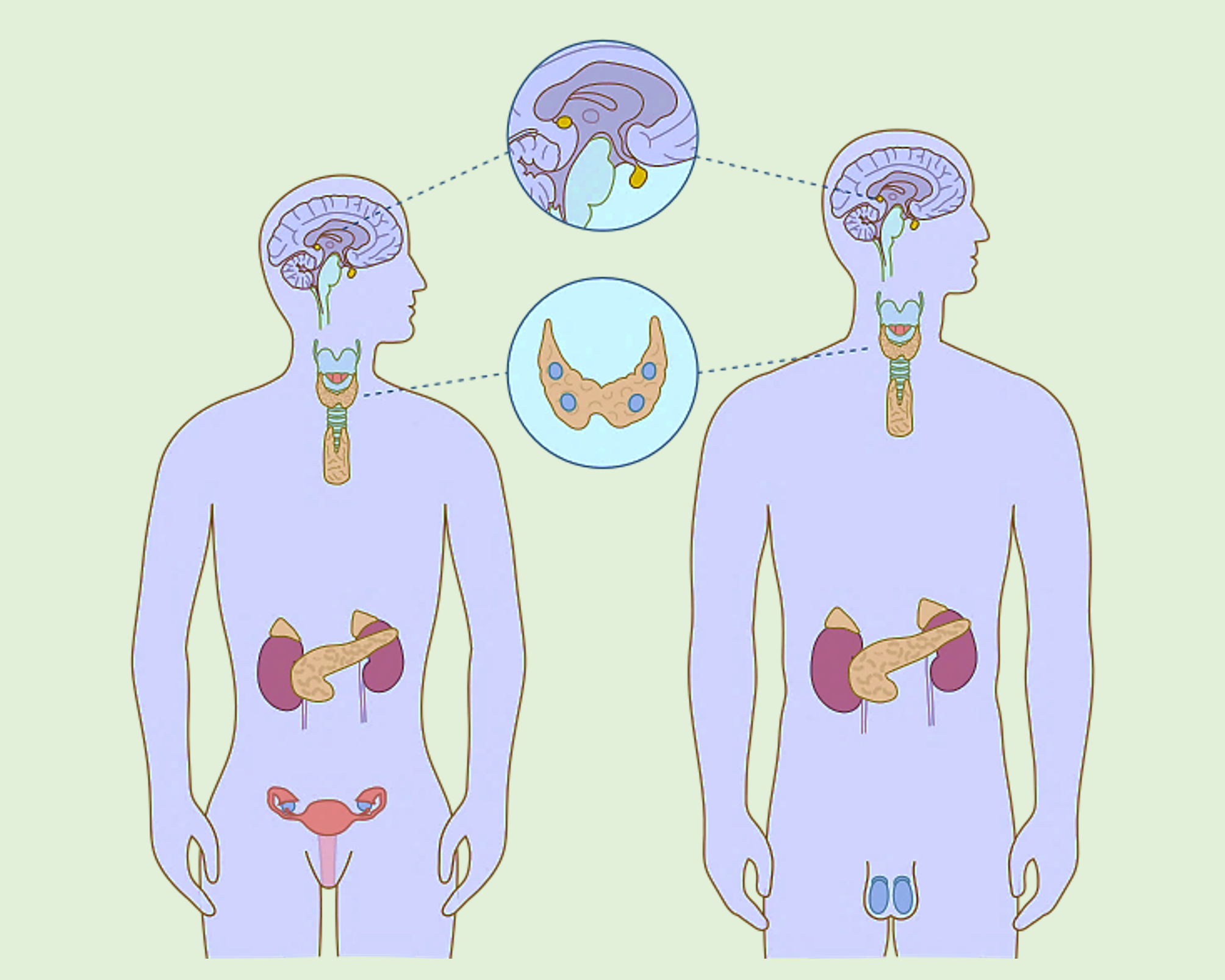
This module will cover the medical terminology of the endocrine system and introduce the anatomy of this system to gain a better understanding of the words and their parts. The endocrine system consists of the endocrine glands located throughout the body and the hormones secreted by these glands. The function of the endocrine system is to assist the nervous system in the control and regulation of body functions through negative feedback. The terms learned here will be useful in many future career paths, such as endocrinology, diabetes medicine, and medical education. The endocrine gland is controlled by the hypothalamus of the brain and works closely with the nervous system to help regulate the body systems, therefore some of the terms seen in the nervous system chapter may also be seen here.
(“Human endocrine male & female” by OpenStax & Tomáš Kebert & umimeto.org is used with a CC BY-SA 4.0 license.)Upon completion of this module, you will be able to:- Identify the anatomy of the endocrine system. (Course Objective 3)
- Describe the main functions of the endocrine system. (Course Objective 3)
- Spell the medical terms related to the endocrine system and use the correct abbreviations. (Course Objectives 2 & 4)
- Pronounce the medical terms related to the endocrine system. (Course Objective 2)
- Identify the medical specialties associated with the endocrine system. (Course Objectives 3 & 5)
- Discuss and describe common diseases, disorders, and procedures related to the endocrine system. (Course Objectives 3 & 5)
To achieve these objectives:
- Read the Module 6 Introduction.
- Read Chapter 6, "Endocrine System" from the Medical Terminology textbook.
- Complete the Practice Activities. (Note: To receive a grade for this, you must click the "Practice Activities" link below.)
- Add your initial posts and responses to the Module 6 Discussion.
- Complete the Module 6 Pronunciation Exercise.
- Complete the Module 6 Quiz.
Module Pressbooks Resources and Activities
Click the links below to access the reading and complete the discussion, exercises, and quiz. -
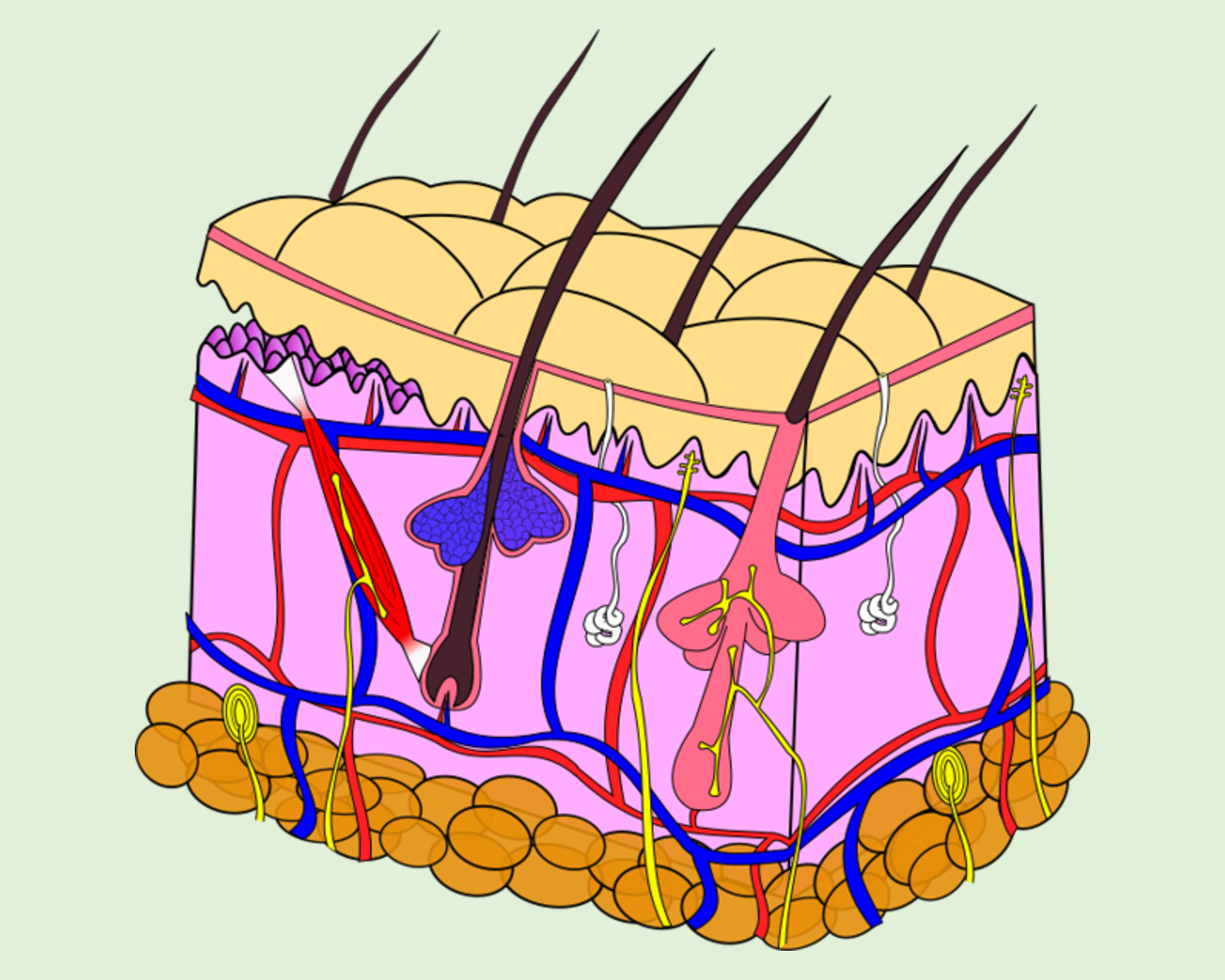
This module will cover the medical terminology of the integumentary system and introduce the anatomy of this system to gain a better understanding of the words and their parts. The integumentary system consists of the skin and its accessory organs. The functions of the integumentary system are protection, thermoregulation, and through the sensory organs located in the skin, the sensation of external stimuli. The terms learned here will be useful in many future career paths, such as medicine, nursing, dermatology, and even cosmetology. The sensory functions of the integumentary system are tied to the nervous system as is the thermoregulatory function, therefore some of the words seen in the nervous system may be seen here as well.
("Skin anatomy" by Sheldahl is used with a CC BY-SA 4.0. license.)
Upon completion of this module, you will be able to:
- Identify the basic anatomy of the integumentary system. (Course Objective 3)
- Describe the main functions of the integumentary system. (Course Objective 3)
- Spell the medical terms related to the integumentary system and use correct abbreviations. (Course Objectives 2 & 4)
- Pronounce the medical terms related to the integumentary system. (Course Objective 2)
- Identify the medical specialties associated with the integumentary system. (Course Objectives 3 & 5)
- Discuss and describe common diseases, disorders, and procedures related to the integumentary system. (Course Objectives 3 & 5)
To achieve these objectives:
- Read the Module 7 Introduction.
- Read Chapter 7, "Integumentary System" from the Medical Terminology textbook.
- Complete the Practice Activities. (Note: To receive a grade for this, you must click the "Practice Activities" link below.)
- Add your initial posts and responses to the Module 7 Discussion.
- Complete the Module 7 Pronunciation Exercise.
- Complete the Module 7 Quiz.
Module Pressbooks Resources and Activities
Click the links below to access the reading and complete the discussion, exercises, and quiz. - Identify the basic anatomy of the integumentary system. (Course Objective 3)
-
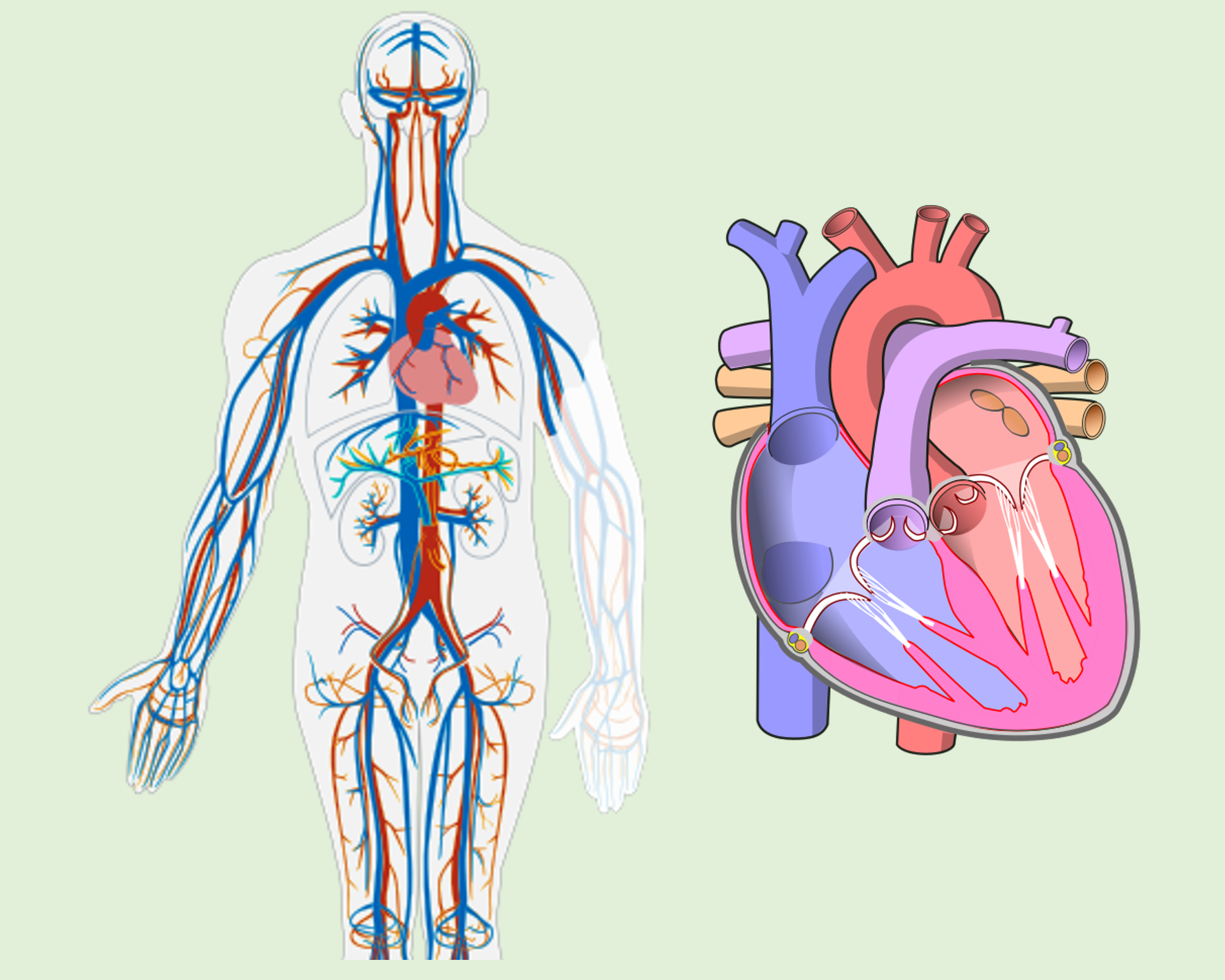
This module will cover the medical terminology of the cardiovascular, immune, and lymphatic systems, and introduce anatomy of these three systems to gain a better understanding of the words and their parts. The cardiovascular system consists of the heart, blood vessels, and blood; the lymphatic system consists of the lymphatic vessels and structures associated with immune cell formation and maturation. Each system has its own functions, such as blood circulation, immunity, and fluid re-circulation, but they are so intertwined, they are often studied together. The terms learned here will be useful in many future career paths, such as cardiology, phlebology, and immunology.
("Circulatory system no tags" by LadyofHats is in the public domain. “Diagram of the human heart (no labels)” by Stenemo is used with a CC BY-SA 4.0 license.)Upon completion of this module, you will be able to:- Identify the anatomy of the cardiovascular, immune, and lymphatic systems. (Course Objective 3)
- Describe the main functions of the cardiovascular, immune, and lymphatic systems. (Course Objective 3)
- Spell the medical terms related to the cardiovascular, immune, and lymphatic systems and use correct abbreviations. (Course Objectives 2 & 4)
- Pronounce the medical terms related to the cardiovascular, immune, and lymphatic systems. (Course Objective 2)
- Identify the medical specialties associated with the cardiovascular, immune, and lymphatic systems. (Course Objectives 3 & 5)
- Discuss and describe common diseases, disorders, and procedures related to the cardiovascular, immune, and lymphatic systems. (Course Objectives 3 & 5)
To achieve these objectives:
- Read the Module 8 Introduction.
- Read Chapters 8, 9, and 10, from the Medical Terminology textbook.
- Complete the Practice Activities after reading each chapter. (Note: To receive a grade for this, you must click the "Practice Activities" link below.)
- Add your initial posts and responses to the Module 8 Discussion.
- Complete the Module 8 Pronunciation Exercise.
- Complete the Module 8 Quiz.
Module Pressbooks Resources and Activities
Click the links below to access the reading and complete the discussion, exercises, and quiz. -
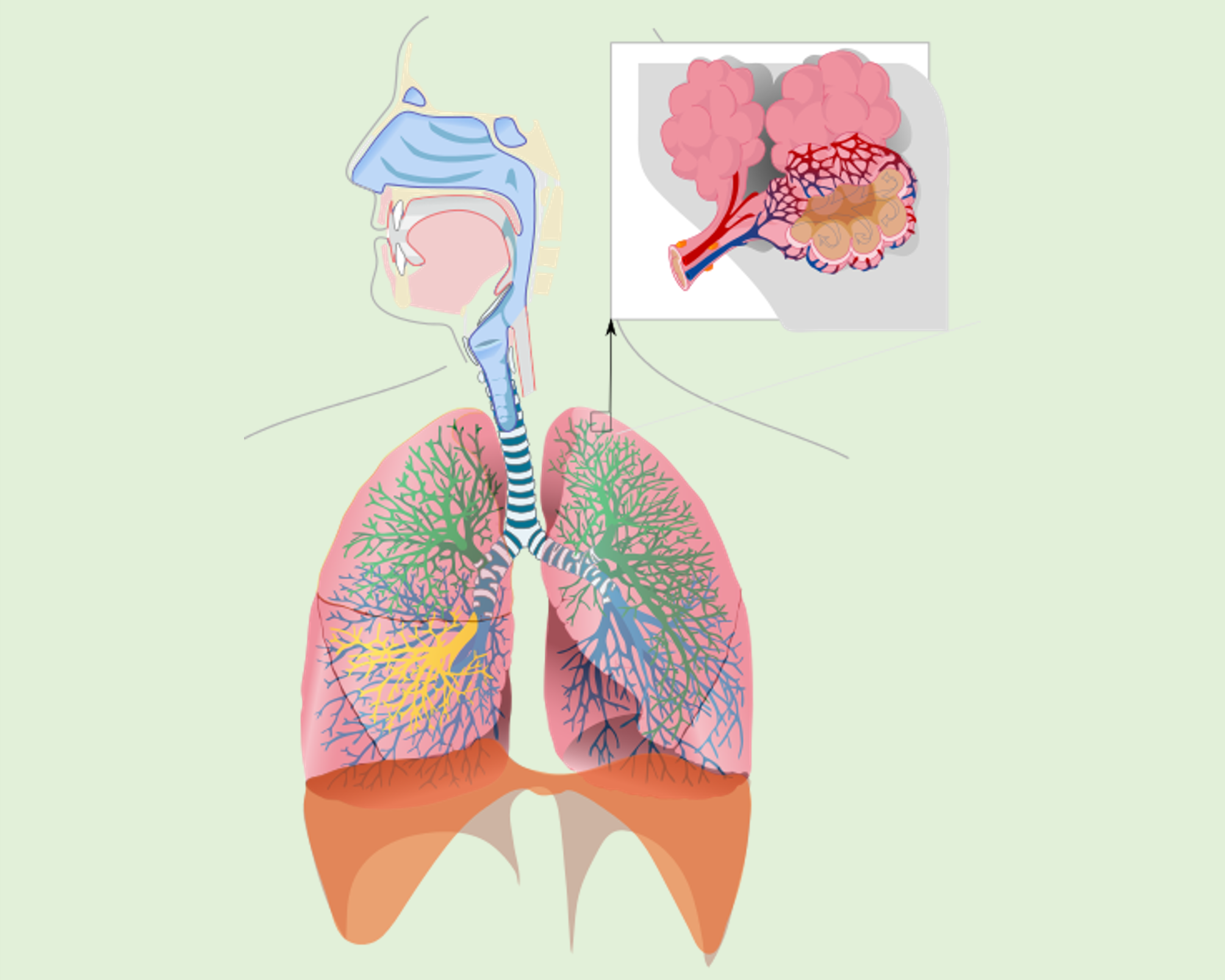
This module will cover the medical terminology of the respiratory system and introduce the anatomy of this system to gain a better understanding of the words and their parts. The respiratory system consists of the nose, the pharynx, the respiratory tree, the lungs, and the muscles of respiration. The function of the respiratory system is primarily to provide oxygen to body tissues for cellular respiration, remove the waste product carbon dioxide, and help to maintain the acid-base balance of body fluids. The terms learned here will be useful in many future career paths, such as respiratory therapy, nursing, and internal medicine. The respiratory system works with the renal system to balance the ph of body fluids, so some of the terms seen here may also be found in the renal chapter.
(“Respiratory system complete no labels” by Bibi Saint-Pol and Jmarchn is used with a CC BY-SA 3.0 license.)Upon completion of this module, you will be able to:- Identify the anatomy of the respiratory system. (Course Objective 3)
- Describe the main functions of the respiratory system. (Course Objective 3)
- Spell the medical terms related to the respiratory system and use the correct abbreviations. (Course Objectives 2 & 4)
- Pronounce the medical terms related to the respiratory system. (Course Objective 2)
- Identify the medical specialties associated with the respiratory system. (Course Objectives 3 & 5)
- Discuss and describe common diseases, disorders, and procedures related to the respiratory system. (Course Objectives 3 & 5)
To achieve these objectives:
- Read the Module 9 Introduction.
- Read Chapter 11, "Respiratory System" from the Medical Terminology textbook.
- Complete the Practice Activities. (Note: To receive a grade for this, you must click the "Practice Activities" link below.)
- Add your initial posts and responses to the Module 9 Discussion.
- Complete the Module 9 Pronunciation Exercise.
- Complete the Module 9 Quiz.
Module Pressbooks Resources and Activities
Click the links below to access the reading and complete the discussion, exercises, and quiz. -

This module will cover the medical terminology of the digestive system and introduce anatomy of this systems to gain a better understanding of the words and their parts. The digestive system consists of the organs that comprise the gastrointestinal tract as well as its accessory organs. The functions of this system include digestion, detoxification, absorption, and excretion. The terms learned here will be useful in many future career paths, such as gastroenterology, proctology, and endoscopy technician.
(“Digestive system without labels” by LadyofHats is in the public domain.)Upon completion of this module, you will be able to:- Identify the anatomy of the digestive system. (Course Objective 3)
- Describe the main functions of the digestive system. (Course Objective 3)
- Spell the medical terms related to the digestive system and use correct abbreviations. (Course Objectives 2 & 4)
- Pronounce the medical terms related to the digestive system. (Course Objective 2)
- Identify the medical specialties associated with the digestive system. (Course Objectives 3 & 5)
- Discuss and describe common diseases, disorders, and procedures related to the digestive system. (Course Objectives 3 & 5)
To achieve these objectives:
- Read the Module 10 Introduction.
- Read Chapter 12, "Digestive System" from the Medical Terminology textbook.
- Complete the Practice Activities. (Note: To receive a grade for this, you must click the "Practice Activities" link below.)
- Add your initial posts and responses to the Module 10 Discussion.
- Complete the Module 10 Pronunciation Exercise.
- Complete the Module 10 Quiz.
Module Pressbooks Resources and Activities
Click the links below to access the reading and complete the discussion, exercises, and quiz. -
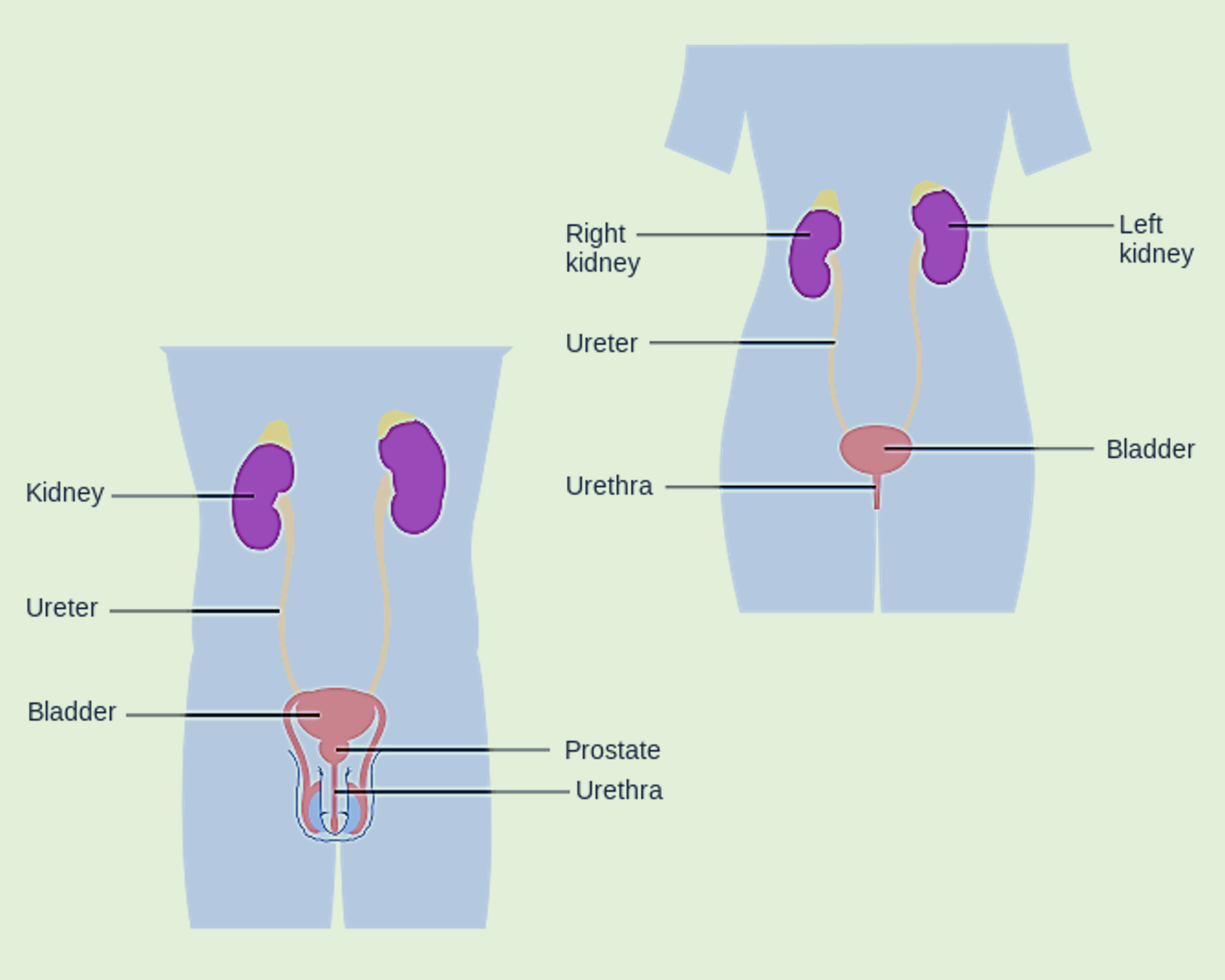
This module will cover the medical terminology of the urinary system and introduce anatomy of this system to gain a better understanding of the words and their parts. The urinary system consists of the kidneys, ureters, urinary bladder, and urethra. Its functions include urine production and regulation of blood homeostasis.. The terms learned here will be useful in many future career paths, such as urology.
(“Diagram of male urinary system CRUK 042” and “Diagram of female urinary system CRUK 301” by Cancer Research UK are used with a CC BY-SA 4.0 license.)Upon completion of this module, you will be able to:- Identify the anatomy of the urinary system. (Course Objective 3)
- Describe the main functions of the urinary system. (Course Objective 3)
- Spell the medical terms related to the urinary system and use correct abbreviations. (Course Objectives 2 & 4)
- Pronounce the medical terms related to the urinary system. (Course Objective 2)
- Identify the medical specialties associated with the urinary system. (Course Objectives 3 & 5)
- Discuss and describe common diseases, disorders, and procedures related to the urinary system. (Course Objectives 3 & 5)
To achieve these objectives:
- Read the Module 11 Introduction.
- Read Chapter 13, "Nervous System" from the Medical Terminology textbook.
- Complete the Practice Activities. (Note: To receive a grade for this, you must click the "Practice Activities" link below.)
- Add your initial posts and responses to the Module 11 Discussion.
- Complete the Module 11 Pronunciation Exercise.
- Complete the Module 11 Quiz.
Module Pressbooks Resources and Activities
Click the links below to access the reading and complete the discussion, exercises, and quiz. -
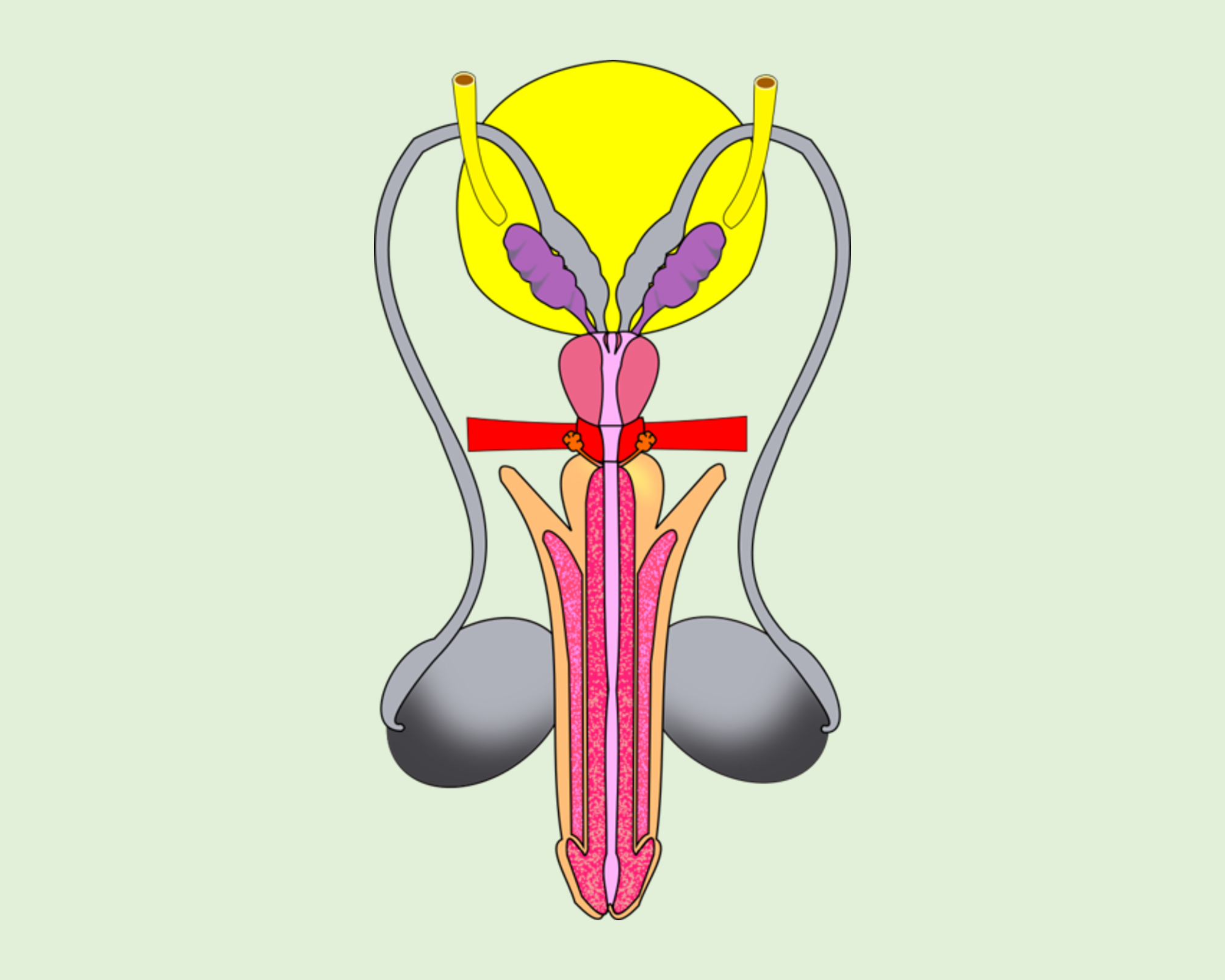
This module will cover the medical terminology of the male reproductive system and introduce the anatomy and physiology of this system. The male reproductive system has reproductive organs, or genitals, consisting of gametes, the reproductive cells that combine to form a fetus. The function of the male reproductive system is to produce, maintain, and transport sperm and semen. The terms learned here will be useful in many future career paths in the medical field such as andrology, endocrinology, and urology.
(“Male reproductive tract” by Sheldahl is used with a CC BY-SA 4.0 license.)
Upon completion of this module, you will be able to:
- Identify the anatomy of the male reproductive system. (Course Objective 3)
- Describe the main functions of the male reproductive system. (Course Objective 3)
- Spell the medical terms related to the male reproductive system and use correct abbreviations. (Course Objectives 2 & 4)
- Pronounce the medical terms related to the male reproductive system. (Course Objective 2)
- Identify the medical specialties associated with the male reproductive system. (Course Objectives 3 & 5)
- Discuss and describe common diseases, disorders, and procedures related to the male reproductive system. (Course Objectives 3 & 5)
To achieve these objectives by:- Read the Module 12 Introduction.
- Read Chapter 14, "Male Reproductive System" from the Medical Terminology textbook.
- Complete the Practice Activities. (Note: To receive a grade for this, you must click the "Practice Activities" link below.)
- Add your initial posts and responses to the Module 12 Discussion.
- Complete the Module 12 Pronunciation Exercise.
- Complete the Module 12 Quiz.
Module Pressbooks Resources and Activities
Click the links below to access the reading and complete the discussion, exercises, and quiz. -
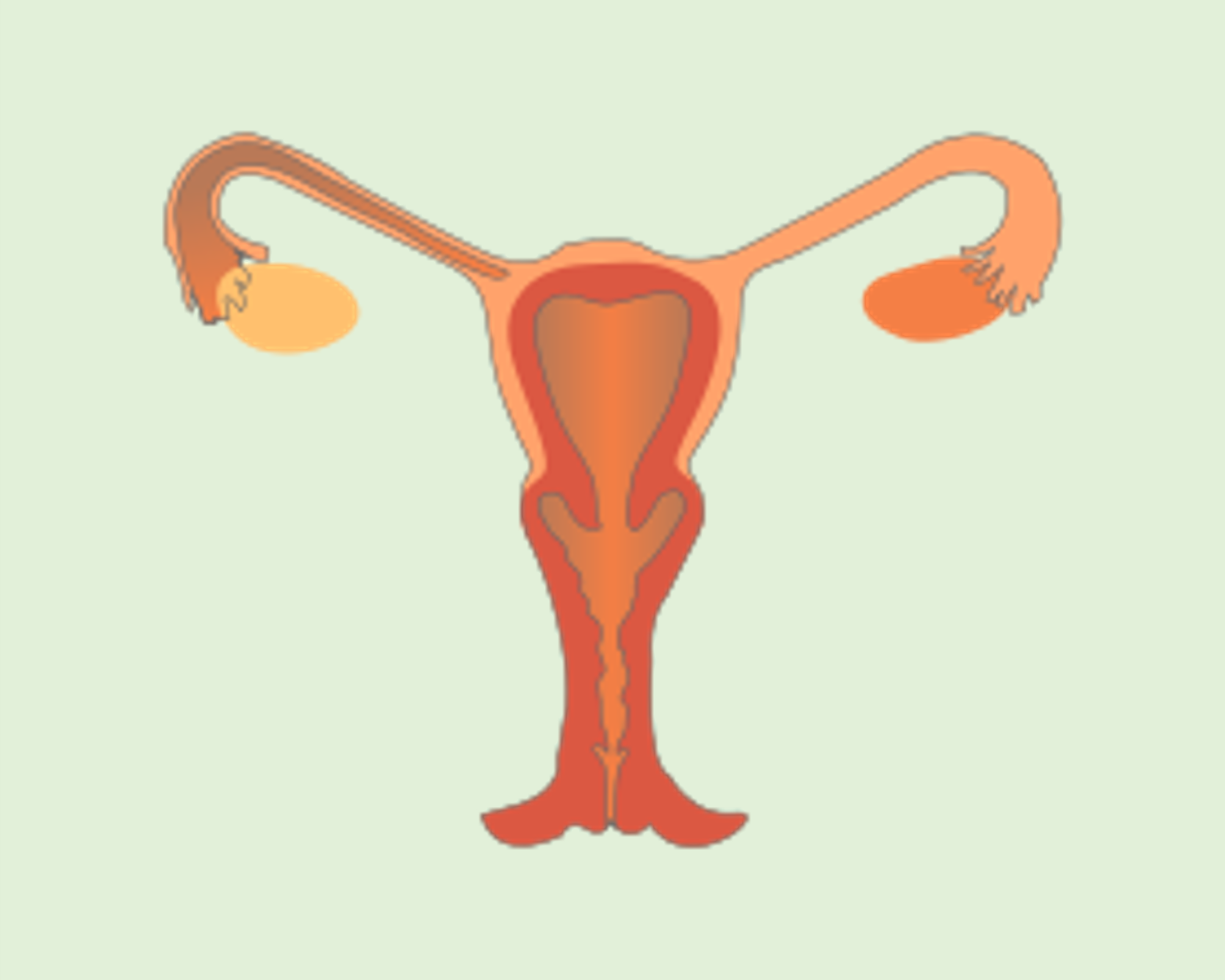 This module will cover the medical terminology of the female reproductive system and introduce the anatomy and physiology of this system. The female reproductive system has reproductive organs, or genital, consisting of female gonads called ovaries found in the pelvic cavity. The female reproductive system functions to produce gametes and reproductive hormones along with supporting the developing fetus and delivers it to the outside world. The terms learned here will be useful in many future career paths in the medical field such as gynecology, obstetrics, and endorcrinology.Upon completion of this module, you will be able to:
This module will cover the medical terminology of the female reproductive system and introduce the anatomy and physiology of this system. The female reproductive system has reproductive organs, or genital, consisting of female gonads called ovaries found in the pelvic cavity. The female reproductive system functions to produce gametes and reproductive hormones along with supporting the developing fetus and delivers it to the outside world. The terms learned here will be useful in many future career paths in the medical field such as gynecology, obstetrics, and endorcrinology.Upon completion of this module, you will be able to:- Identify the anatomy of the female reproductive system. (Course Objective 3)
- Describe the main functions of the female reproductive system. (Course Objective 3)
- Spell the medical terms related to the female reproductive system and use correct abbreviations. (Course Objectives 2 & 4)
- Pronounce the medical terms related to the female reproductive system. (Course Objective 2)
- Identify the medical specialties associated with the female reproductive system. (Course Objectives 3 & 5)
- Discuss and describe common diseases, disorders, and procedures related to the female reproductive system. (Course Objectives 3 & 5)
To achieve these objectives:- Read the Module 13 Introduction.
- Read Chapter 15, "Female Reproductive System" from the Medical Terminology textbook.
- Complete the Practice Activities. (Note: To receive a grade for this, you must click the "Practice Activities" link below.)
- Add your initial posts and responses to the Module 13 Discussion.
- Complete the Module 13 Pronunciation Exercise.
- Complete the Module 13 Quiz.
Module Pressbooks Resources and Activities
Click the links below to access the reading and complete the discussion, exercises, and quiz.
-
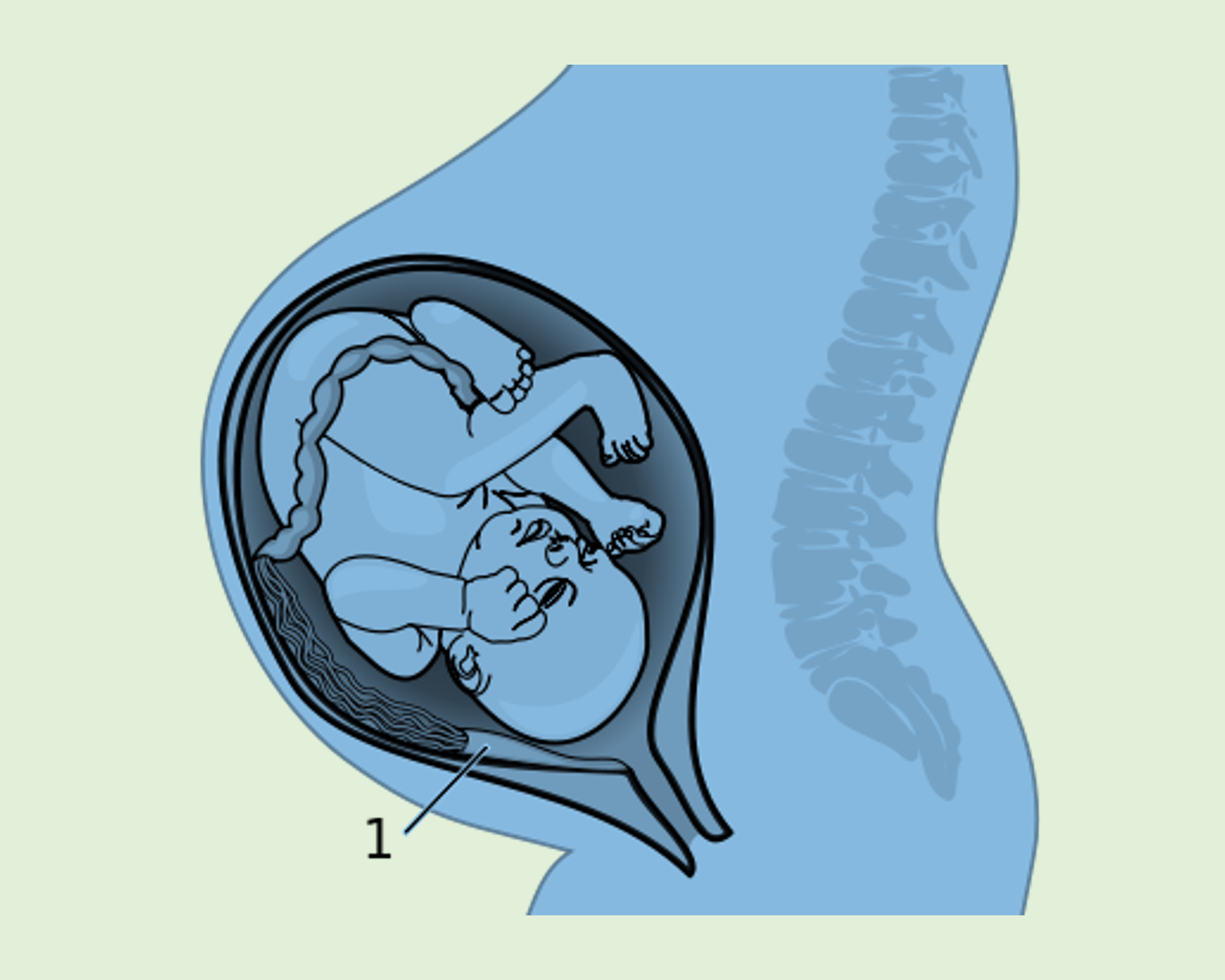
This module will cover the medical terminology related to pregnancy, childbirth, and the newborn infant, and introduce anatomy related to these stages to gain a better understanding of the words and their parts. This module will build on terms learned in the Female Reproductive System module. The terms learned here will be useful in many future career paths, such as obstetrics, gynecology, and midwifery.
Upon completion of this module, you will be able to:- Identify the common processes in obstetrics. (Course Objective 3)
- Describe the specialty of obstetrics. (Course Objective 3)
- Spell the medical terms used in obstetrics and use correct abbreviations. (Course Objectives 2 & 4)
- Pronounce the medical terms used in obstetrics. (Course Objective 2)
- Identify the medical specialties associated with obstetrics and neonatology. (Course Objectives 3 & 5)
- Discuss and describe common complications and procedures related to obstetrics and neonatology. (Course Objectives 3 & 5)
To achieve these objectives:
- Read the Module 14 Introduction.
- Read Chapter 16, "Embryology, Pregnancy, and Neonatology" from the Medical Terminology textbook.
- Complete the Practice Activities. (Note: To receive a grade for this, you must click the "Practice Activities" link below.)
- Add your initial posts and responses to the Module 14 Discussion.
- Complete the Module 14 Pronunciation Exercise.
- Complete the Module 14 Quiz.
Module Pressbooks Resources and Activities
Click the links below to access the reading and complete the discussion, exercises, and quiz. -
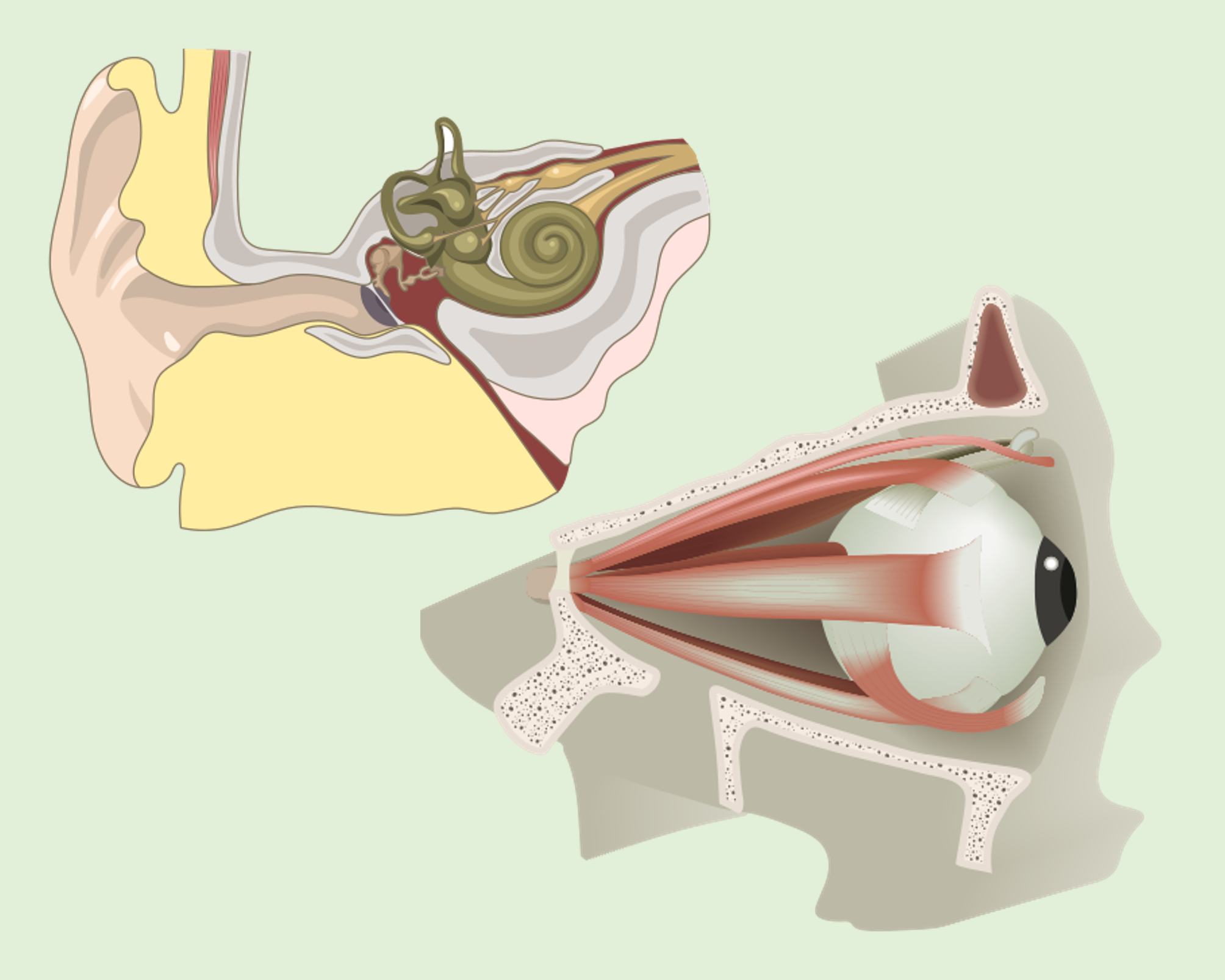
This module will cover the medical terminology of the eye and ear and introduce anatomy of these two structures to gain a better understanding of the words and their parts. The eye and ear are responsible for the senses of vision, hearing, and balance. The terms learned here will be useful in many future career paths, such as optometry, ophthalmology, and audiology.
(“202108 Ear structure” and “20211 Eye” by DataBase Center for Life Science are used with a CC BY-SA 4.0 license.)
Upon completion of this module, you will be able to:
- Identify the anatomy of the eye and ear system. (Course Objective 3)
- Describe the main functions of the eye and ear. (Course Objective 3)
- Spell the medical terms related to the eye and ear and use correct abbreviations. (Course Objectives 2 & 4)
- Pronounce the medical terms related to the eye and ear. (Course Objective 2)
- Identify the medical specialties associated with the eye and ear (sight and sound). (Course Objectives 3 & 5)
- Discuss and describe common diseases, disorders, and procedures related to the eye and ear. (Course Objectives 3 & 5)
To achieve these objectives:
- Read the Module 15 Introduction.
- Read Chapter 17, "Eye and Ear" from the Medical Terminology textbook.
- Complete the Practice Activities. (Note: To receive a grade for this, you must click the "Practice Activities" link below.)
- Add your initial posts and responses to the Module 15 Discussion.
- Complete the Module 15 Pronunciation Exercise.
- Complete the Module 15 Quiz.
Module Pressbooks Resources and Activities
Click the links below to access the reading and complete the discussion, exercises, and quiz. -
 In this module, you will take the final exam for this course. This exam is a 100-question mastery exam that will gauge the knowledge you have gained of word parts, their meanings, and the rules for their use, by testing the proficiency with which you recognize and understand medical terminology. Read the instructions carefully and take note of any special submission guidelines.
In this module, you will take the final exam for this course. This exam is a 100-question mastery exam that will gauge the knowledge you have gained of word parts, their meanings, and the rules for their use, by testing the proficiency with which you recognize and understand medical terminology. Read the instructions carefully and take note of any special submission guidelines.(“Study” by Nick Young is used with a CC BY-SA 3.0 license.)
Upon completion of this module, you will have:
- Read and viewed the final exam instructions
- Log into the exam or proctoring service (if applicable)
- Completed the final exam and submitted the results per instructions (if applicable)
